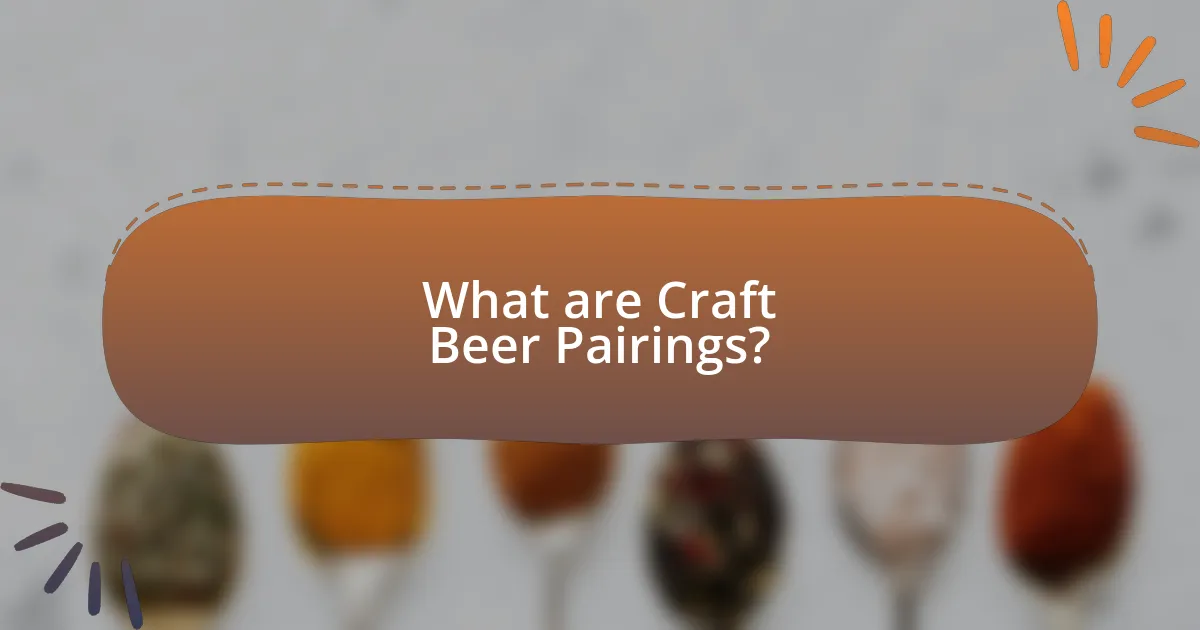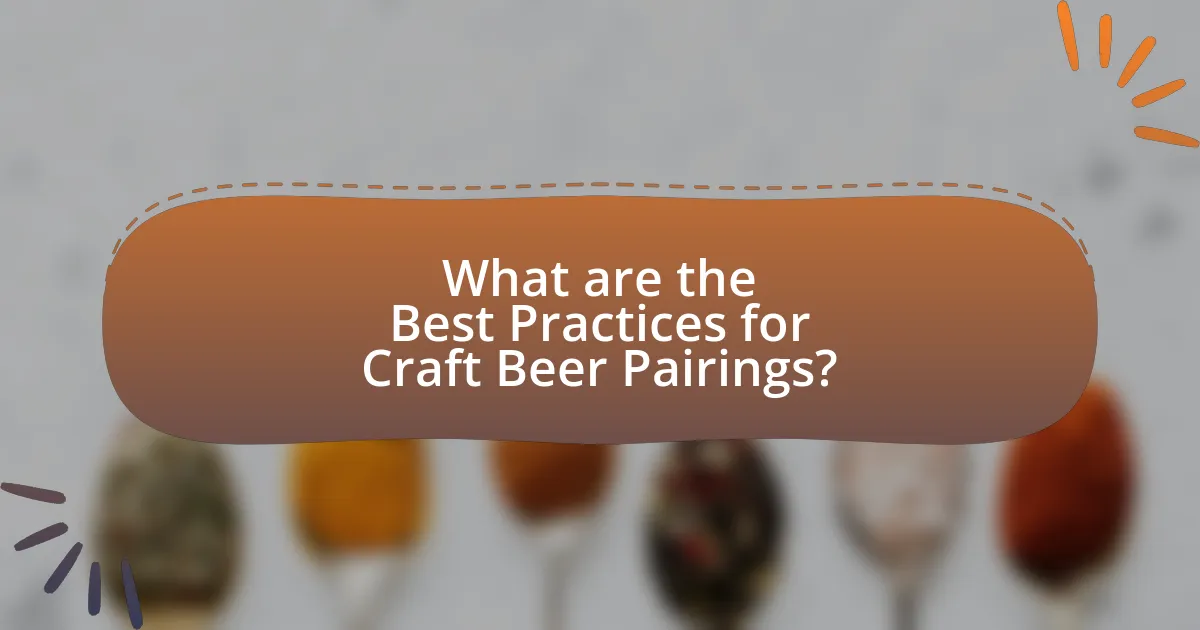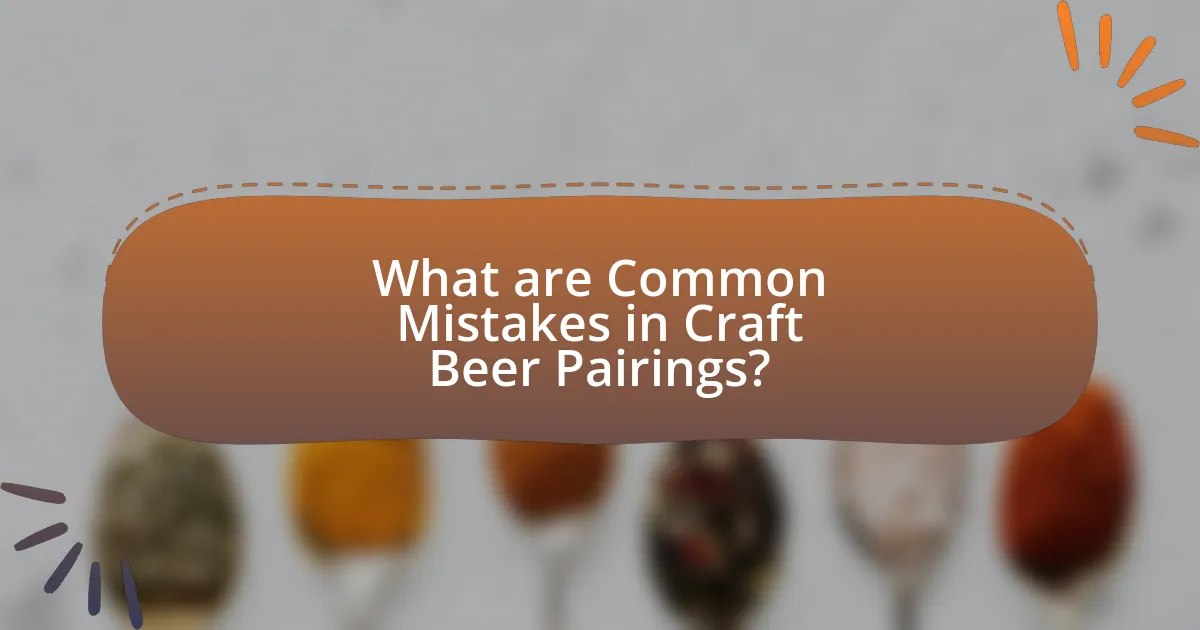Craft beer pairings involve matching specific craft beers with particular foods to enhance the overall dining experience by complementing or contrasting flavors. This practice not only elevates the taste of both the beer and the food but also enriches the pub experience, encouraging exploration of diverse flavors and fostering social interactions. Key factors influencing beer pairings include flavor profiles, food characteristics, and personal preferences, while understanding beer styles is crucial for maximizing enjoyment. The article also addresses common mistakes in pairings, the impact of ambiance on tasting experiences, and practical tips for experimenting with pairings at home.

What are Craft Beer Pairings?
Craft beer pairings refer to the practice of matching specific craft beers with particular foods to enhance the overall dining experience. This approach is based on the understanding that the flavors and aromas of craft beers can complement or contrast with various dishes, thereby elevating the taste of both the beer and the food. For example, a hoppy IPA can balance the richness of a spicy dish, while a malty stout may enhance the flavors of chocolate desserts. The effectiveness of these pairings is supported by culinary principles that emphasize flavor compatibility, such as the use of bitterness to cut through fat or the pairing of sweet beers with salty foods.
How do Craft Beer Pairings enhance the pub experience?
Craft beer pairings enhance the pub experience by creating a harmonious relationship between food and beverage, which elevates flavor profiles and overall enjoyment. When specific craft beers are paired with complementary dishes, such as a hoppy IPA with spicy wings or a rich stout with chocolate desserts, the combination can intensify flavors and provide a more satisfying dining experience. Research indicates that food and drink pairings can enhance sensory perception, leading to greater satisfaction and enjoyment during meals. This synergy not only encourages patrons to explore diverse flavors but also fosters a social atmosphere, as sharing recommendations and experiences around pairings can enhance interactions among guests.
What factors influence the choice of beer pairings?
The choice of beer pairings is influenced by flavor profiles, food characteristics, and personal preferences. Flavor profiles include the beer’s bitterness, sweetness, acidity, and body, which must complement or contrast with the dish being served. Food characteristics such as richness, spiciness, and texture also play a crucial role; for example, a hoppy IPA can cut through the richness of a fatty dish, while a malty stout may enhance the flavors of chocolate desserts. Personal preferences, including individual taste and cultural influences, further shape pairing decisions, as people often gravitate towards familiar flavors or styles.
How do flavors in food and beer complement each other?
Flavors in food and beer complement each other by enhancing the overall tasting experience through balance and contrast. When food and beer are paired thoughtfully, the beer can amplify certain flavors in the dish while also providing a refreshing counterpoint to richer or spicier elements. For example, a hoppy IPA can cut through the richness of a fatty dish, while a malty stout can enhance the sweetness of a dessert. Studies have shown that specific flavor compounds in beer, such as esters and phenols, interact with the taste receptors in the mouth, creating a synergistic effect that elevates both the food and the beverage. This principle of pairing is rooted in culinary traditions and is supported by sensory analysis research, which indicates that complementary flavors can lead to a more satisfying dining experience.
Why is it important to consider beer styles in pairings?
Considering beer styles in pairings is crucial because different styles possess unique flavor profiles that can enhance or clash with food. For instance, a hoppy IPA can complement spicy dishes due to its bitterness, while a rich stout can enhance the flavors of chocolate desserts. This alignment between beer characteristics and food flavors maximizes the overall tasting experience, making it more enjoyable. Studies have shown that proper pairings can elevate the sensory experience, leading to greater satisfaction among consumers.
What are the main types of craft beer styles?
The main types of craft beer styles include ales, lagers, stouts, porters, IPAs (India Pale Ales), and sours. Ales are characterized by their top fermentation process and include sub-styles like pale ales and Belgian ales. Lagers, which undergo bottom fermentation, are known for their clean and crisp taste, with popular varieties such as pilsners and bocks. Stouts and porters are dark beers that often feature roasted malt flavors, while IPAs are known for their hoppy bitterness and aromatic qualities. Sours, which can be produced through wild fermentation, offer a tart and complex flavor profile. These classifications help consumers navigate the diverse offerings in the craft beer market.
How does each beer style interact with different foods?
Each beer style interacts with different foods based on its flavor profile, body, and carbonation level. For example, light lagers complement seafood and salads due to their crispness, while hoppy IPAs enhance spicy dishes by balancing heat with bitterness. Stouts and porters pair well with rich desserts like chocolate cake, as their roasted malt flavors can accentuate sweetness. Wheat beers, with their fruity and citrus notes, work well with light dishes such as chicken or salads. Additionally, sour beers can cut through fatty foods, making them suitable for rich cheeses or fried items. These pairings are supported by the principle that complementary flavors enhance the overall dining experience, as noted in various culinary studies on food and beverage pairing.

What are the Best Practices for Craft Beer Pairings?
The best practices for craft beer pairings involve matching the beer’s flavor profile with the food’s characteristics. For instance, hoppy IPAs complement spicy dishes, while malty stouts pair well with rich desserts. Additionally, contrasting flavors can enhance the dining experience; a sour beer can balance fatty foods. Research indicates that pairing beer with food enhances both the taste of the beer and the meal, creating a more enjoyable experience. This is supported by studies showing that flavor interactions can elevate sensory perceptions, making thoughtful pairings essential for maximizing enjoyment.
How can you effectively pair craft beer with food?
To effectively pair craft beer with food, consider the flavor profiles of both the beer and the dish. Matching complementary flavors enhances the dining experience; for example, a hoppy IPA pairs well with spicy foods, as the bitterness balances the heat. Conversely, a malty stout complements rich desserts like chocolate cake, as the sweetness of the beer enhances the flavors of the dessert. Research indicates that pairing beer with food can elevate taste perception, making the meal more enjoyable. A study published in the Journal of Culinary Science & Technology found that proper pairings can enhance the overall flavor experience by up to 30%.
What are some classic food and beer pairing combinations?
Classic food and beer pairing combinations include the following:
- Beer-Battered Fish and Lager: The crispiness of beer-battered fish complements the light, refreshing qualities of a lager, enhancing the overall dining experience.
- Spicy Chicken Wings and IPA: The bitterness of an India Pale Ale balances the heat from spicy chicken wings, making this a popular choice among beer enthusiasts.
- Cheeseburgers and Stout: The rich, roasted flavors of a stout pair well with the savory, juicy characteristics of a cheeseburger, creating a satisfying combination.
- Pizza and Pale Ale: The hoppy notes of a pale ale enhance the flavors of pizza, particularly those with tomato-based sauces and cheese.
- Chocolate Desserts and Porter: The deep, chocolatey flavors of a porter complement rich chocolate desserts, providing a harmonious pairing.
These combinations are widely recognized in culinary circles and are often recommended by chefs and beer sommeliers for their ability to enhance flavors and elevate the dining experience.
How can seasonal ingredients influence beer pairings?
Seasonal ingredients significantly influence beer pairings by enhancing flavor compatibility and freshness. For instance, summer fruits like peaches or berries can complement light, fruity beers such as wheat ales or IPAs, creating a refreshing experience. Conversely, winter ingredients like spices or roasted malts pair well with darker beers, such as stouts or porters, providing warmth and depth. This alignment of seasonal flavors with beer styles not only elevates the tasting experience but also reflects the natural availability of ingredients, ensuring that pairings are both timely and relevant.
What role does the pub atmosphere play in beer pairings?
The pub atmosphere significantly influences beer pairings by enhancing the overall sensory experience of the drink. A lively and social environment can elevate the enjoyment of specific beer styles, as the ambiance often complements the flavors and aromas of the beer. For instance, a cozy pub with warm lighting may encourage the pairing of rich, malty beers, while a vibrant, bustling bar might be more suited for refreshing, hoppy IPAs. Research indicates that environmental factors, such as lighting and noise levels, can affect taste perception, suggesting that the atmosphere can alter how flavors are experienced. Therefore, the pub setting not only serves as a backdrop but actively shapes the way patrons perceive and enjoy their beer pairings.
How can ambiance enhance the tasting experience?
Ambiance can significantly enhance the tasting experience by creating an environment that stimulates the senses and influences perception. A well-designed ambiance, including lighting, music, and decor, can evoke emotions and set the mood, which in turn affects how flavors are perceived. Research indicates that factors such as background music can alter taste perception; for example, studies show that softer music can enhance the enjoyment of sweeter flavors, while louder music may amplify bitterness. Additionally, a comfortable and inviting atmosphere encourages relaxation, allowing individuals to focus on the nuances of the craft beer, ultimately leading to a more enjoyable tasting experience.
What are the best pub settings for enjoying craft beer pairings?
The best pub settings for enjoying craft beer pairings include establishments that prioritize a diverse selection of craft beers and offer a menu designed for complementary food pairings. Pubs with knowledgeable staff who can recommend specific beer and food combinations enhance the experience, as they can guide patrons through the nuances of flavor profiles. Additionally, settings that provide a relaxed atmosphere, such as those with communal tables or outdoor seating, encourage social interaction, which can enrich the tasting experience. Research indicates that environments that foster social engagement can enhance the enjoyment of food and drink, making these settings particularly effective for craft beer pairings.

What are Common Mistakes in Craft Beer Pairings?
Common mistakes in craft beer pairings include ignoring the flavor profiles of both the beer and the food, which can lead to mismatched tastes. For instance, pairing a light lager with a heavily spiced dish can overwhelm the beer’s subtle flavors, while a strong stout may overpower delicate seafood. Additionally, many people fail to consider the carbonation levels; high carbonation can enhance or detract from the food experience, such as pairing a highly carbonated beer with creamy dishes, which can create an unpleasant mouthfeel. Another frequent error is not accounting for the intensity of flavors; pairing a robust beer with equally strong flavors is essential for balance, as seen in pairing IPAs with spicy foods. Lastly, some individuals overlook the importance of temperature; serving beer too cold can mute flavors, while serving it too warm can enhance undesirable notes.
What should you avoid when pairing craft beer with food?
When pairing craft beer with food, you should avoid mismatching flavors that clash or overwhelm each other. For example, pairing a highly bitter IPA with a delicate seafood dish can overshadow the subtle flavors of the food. Additionally, avoid pairing beers with similar flavor profiles to the food, as this can lead to a lack of contrast and excitement in the dining experience. Research indicates that successful pairings often involve balancing intensity and complementing flavors, which enhances the overall enjoyment of both the beer and the food.
How can mismatched flavors ruin the pairing experience?
Mismatched flavors can ruin the pairing experience by creating discord between the food and beverage, leading to an unbalanced taste profile. When flavors clash, such as a bitter beer with a sweet dish, the intended enjoyment of both elements diminishes, often resulting in one overpowering the other. Research indicates that successful pairings enhance the overall sensory experience, while mismatched combinations can lead to negative perceptions of both the food and the beer. For example, a study published in the Journal of Sensory Studies found that participants rated pairings with complementary flavors significantly higher than those with contrasting flavors, highlighting the importance of harmony in flavor profiles for an optimal pairing experience.
What are the consequences of ignoring beer temperature in pairings?
Ignoring beer temperature in pairings can lead to a diminished flavor profile and an overall unsatisfactory drinking experience. When beer is served too cold, the flavors and aromas are muted, preventing the drinker from fully appreciating the beer’s complexity. Conversely, serving beer too warm can result in excessive bitterness and off-flavors becoming pronounced, which can clash with food pairings. Research indicates that optimal serving temperatures enhance the sensory experience, as different styles of beer have specific temperature ranges that best showcase their characteristics. For example, lagers are typically best served cold, while ales benefit from slightly warmer temperatures to release their aromatic compounds.
How can you learn from pairing mistakes?
You can learn from pairing mistakes by analyzing the specific elements that led to an unsatisfactory combination of craft beer and food. Identifying the flavors, aromas, and textures that clashed or failed to complement each other allows for better future decisions. For instance, if a hoppy IPA overwhelmed a delicate seafood dish, recognizing this imbalance can guide future pairings towards more harmonious choices, such as a light lager or a wheat beer that enhances rather than competes with the dish. This reflective practice is supported by studies in flavor chemistry, which indicate that understanding the interactions between different taste profiles can significantly improve pairing outcomes.
What resources are available for improving your pairing skills?
To improve your pairing skills, consider utilizing books, online courses, and tasting events focused on craft beer and food pairings. Books such as “The Beer and Food Companion” by food and beer expert, Stephen Beaumont, provide detailed insights into flavor profiles and pairing techniques. Online platforms like Coursera and Udemy offer courses specifically designed to enhance knowledge in beer styles and pairing strategies. Additionally, attending local tasting events or beer festivals allows for practical experience and direct interaction with experts in the field, further solidifying your understanding of effective pairings.
How can tasting events help refine your pairing knowledge?
Tasting events can significantly refine your pairing knowledge by providing direct, experiential learning opportunities. During these events, participants can sample various craft beers alongside complementary foods, allowing them to observe and understand how different flavors interact. Research indicates that sensory experiences enhance learning retention; thus, tasting events facilitate a deeper comprehension of flavor profiles and pairing principles. For instance, a study published in the Journal of Sensory Studies found that participants who engaged in guided tastings demonstrated improved ability to identify and articulate flavor pairings compared to those who learned through traditional methods. This hands-on approach not only builds confidence in making pairing decisions but also fosters a more nuanced appreciation for the complexities of craft beer and food combinations.
What are some practical tips for Craft Beer Pairings?
To enhance craft beer pairings, consider matching the beer’s flavor profile with the food’s characteristics. For example, hoppy IPAs complement spicy dishes due to their bitterness, which balances heat. Conversely, malty stouts pair well with rich desserts like chocolate cake, as the sweetness of the beer enhances the dessert’s flavors. Additionally, lighter beers such as pilsners work well with seafood, as their crispness highlights the freshness of the dish. These pairing strategies are supported by the principle that complementary flavors create a harmonious dining experience, making the overall meal more enjoyable.
How can you experiment with different pairings at home?
To experiment with different pairings at home, start by selecting a variety of craft beers and complementary foods. For instance, pairing a hoppy IPA with spicy foods enhances the beer’s bitterness while balancing the heat. Research indicates that flavor compounds in beer can interact with food, creating a more enjoyable tasting experience. Additionally, consider hosting a tasting session with friends to explore various combinations, allowing for feedback and shared preferences, which can further refine your pairing skills.
What tools can assist in finding the perfect beer and food match?
Tools that can assist in finding the perfect beer and food match include beer pairing apps, websites, and guides. These resources provide curated recommendations based on flavor profiles, beer styles, and food types. For example, the app “Untappd” allows users to explore beer ratings and food pairings based on community feedback, while websites like “BeerAdvocate” offer extensive pairing suggestions and user-generated content. Additionally, books such as “The Beer Bible” by Jeff Alworth provide in-depth insights into beer styles and their ideal food companions, enhancing the pairing experience.
